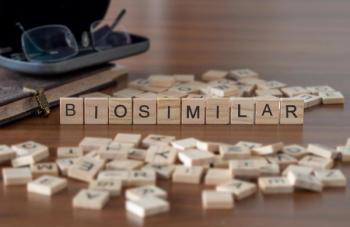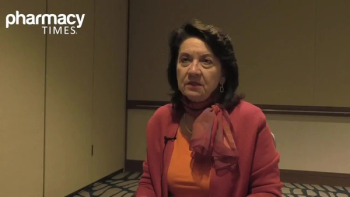
Oncology Overview: Enfortumab vedotin-ejfv for Advanced or Metastatic Urothelial Cancer
Enfortumab vedotin-ejfv (Seagen; Padcev) is a first-in-class antibody-drug conjugate approved for patients with previously treated locally advanced or metastatic urothelial cancer.
Enfortumab vedotin-ejfv (Seagen, Astellas; Padcev) is a first-in-class antibody-drug conjugate (ADC) directed against Nectin-4 with a microtubule disrupter, monomethyl auristatin (MMAE).1 The FDA approved enfortumab vedotin-ejfv on December 18, 2019, for patients with previously treated locally advanced or metastatic urothelial cancer.1,2
Indications and Dosage
Eligible patients must have previously received a programmed death receptor or ligand inhibitor (PD-1/PD-L1), such as pembrolizumab, and a platinum-containing chemotherapy, such as cisplatin, or have been previously treated but ineligible for platinum-based chemotherapy.2
Enfortumab vedotin-ejfv is a lyophilized powder for reconstitution in sterile water for injection. Pharmacy staff reconstitutes it with 5% dextrose, 0.9% sodium chloride, or lactated Ringer’s solution for injection.2 Patients receive 1.25 mg/kg (maximum 125 mg) infused over 30 minutes on days 1, 8, and 15 of a 28-day cycle.
Patients continue treatment with enfortumab vedotin-ejfv until disease progression or unacceptable toxicity. If unacceptable toxicity arises, enfortumab vedotin-ejfv can be dose-adjusted as follows:2,3
Mechanism of Action
Enfortumab vedotin-ejfv selectively delivers its attached drug, MMAE, directly to tumor cells to inhibit microtubule formation. Nectin-4 is transmembrane adhesion protein found on cell surfaces and is expressed in over 80% of bladder cancers; 98% of patients treated in enfortumab vedotin-ejfv’s phase 3 clinical trial had Nectin-4 overexpression.2
A fully human IgG1-kappa antibody selectively binds to this receptor, which then becomes internalized and proteolytically cleaved to release MMAE.1-3 MMAE works in a similar manner to vincristine and vinblastine, but with greater affinity and longer duration of microtubule disruption.4
Warnings and Precautions
Enfortumab vedotin-ejfv’s labeling includes a boxed warning for serious skin reactions, including Stevens-Johnson syndrome (SJS) and toxic epidermal necrolysis (TEN).2 Enfortumab vedotin-ejfv is contradicted in those with uncontrolled diabetes (A1C > 8%) or when blood glucose exceeds 250 mg/dL.2
The most common reactions (>20%) are as follows:2
- Fatigue (56%)
- Peripheral neuropathy (56%)
- Decreased appetite (52%)
- Rash (52%)
- Alopecia (50%)
- Nausea (45%)
- Diarrhea (42%)
- Dysgeusia (42%)
- Dry eye (40%)
- Pruritis (26%)
- Dry skin (26%)
Counseling/Pregnancy Lactation
MMAE is a cytochrome 3A4 substrate; use of MMAE with strong cytochrome 3A4 inhibitors may increase patient exposure to MMAE. For ocular adverse effects, such as vision changes and dry eye, consider prophylactic treatment with artificial tears and topical steroids after an ophthalmic exam.2,4
Enfortumab vedotin-ejfv has been shown to cause embryo-fetal toxicity in animal models. Women taking enfortumab vedotin-ejfv should use an effective form of birth control. Additionally, breast feeding is contradicted in those taking enfortumab vedotin-ejfv.2-4
About the Author
Canyon Hopkins, PharmD, is a medical professional for Ethos Cannabis.
References
- FDA. FDA approves new type of therapy to treat advanced UROTHELIAL cancer. U.S. Food and Drug Administration. https://www.fda.gov/news-events/press-announcements/fda-approves-new-type-therapy-treat-advanced-urothelial-cancer. Published December 18, 2019. Accessed July 27, 2021.
- Highlights of Prescribing Information: Padcev. Access Data FDA. https://www.accessdata.fda.gov/drugsatfda_docs/label/2019/761137s000lbl.pdf. Published 2019. Accessed July 27, 2021.
- Seagen. A study of enfortumab vedotin for patients with locally advanced or metastatic urothelial bladder cancer . A Study of Enfortumab Vedotin for Patients With Locally Advanced or Metastatic Urothelial Bladder Cancer - Full Text View - ClinicalTrials.gov. https://clinicaltrials.gov/ct2/show/NCT03219333. Published July 2017. Accessed July 27, 2021.
- Waight AB, Bargsten K, Doronina S, Steinmetz MO, Sussman D, Prota AE. Structural basis OF Microtubule DESTABILIZATION by Potent auristatin anti-mitotics. PloS one. https://www.ncbi.nlm.nih.gov/pmc/articles/PMC4982639/. Published August 12, 2016. Accessed July 27, 2021.
Newsletter
Stay informed on drug updates, treatment guidelines, and pharmacy practice trends—subscribe to Pharmacy Times for weekly clinical insights.

















































































































































































































